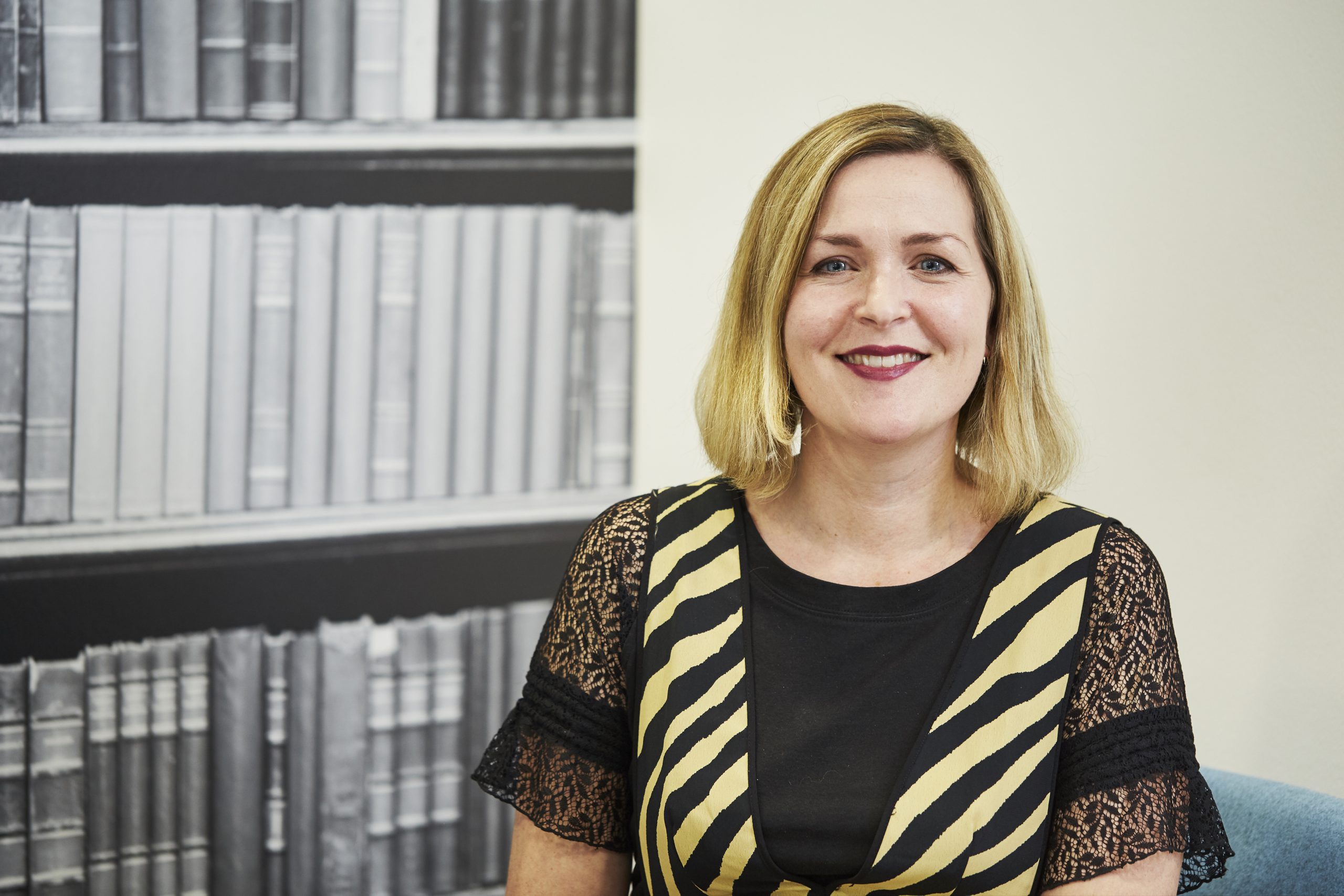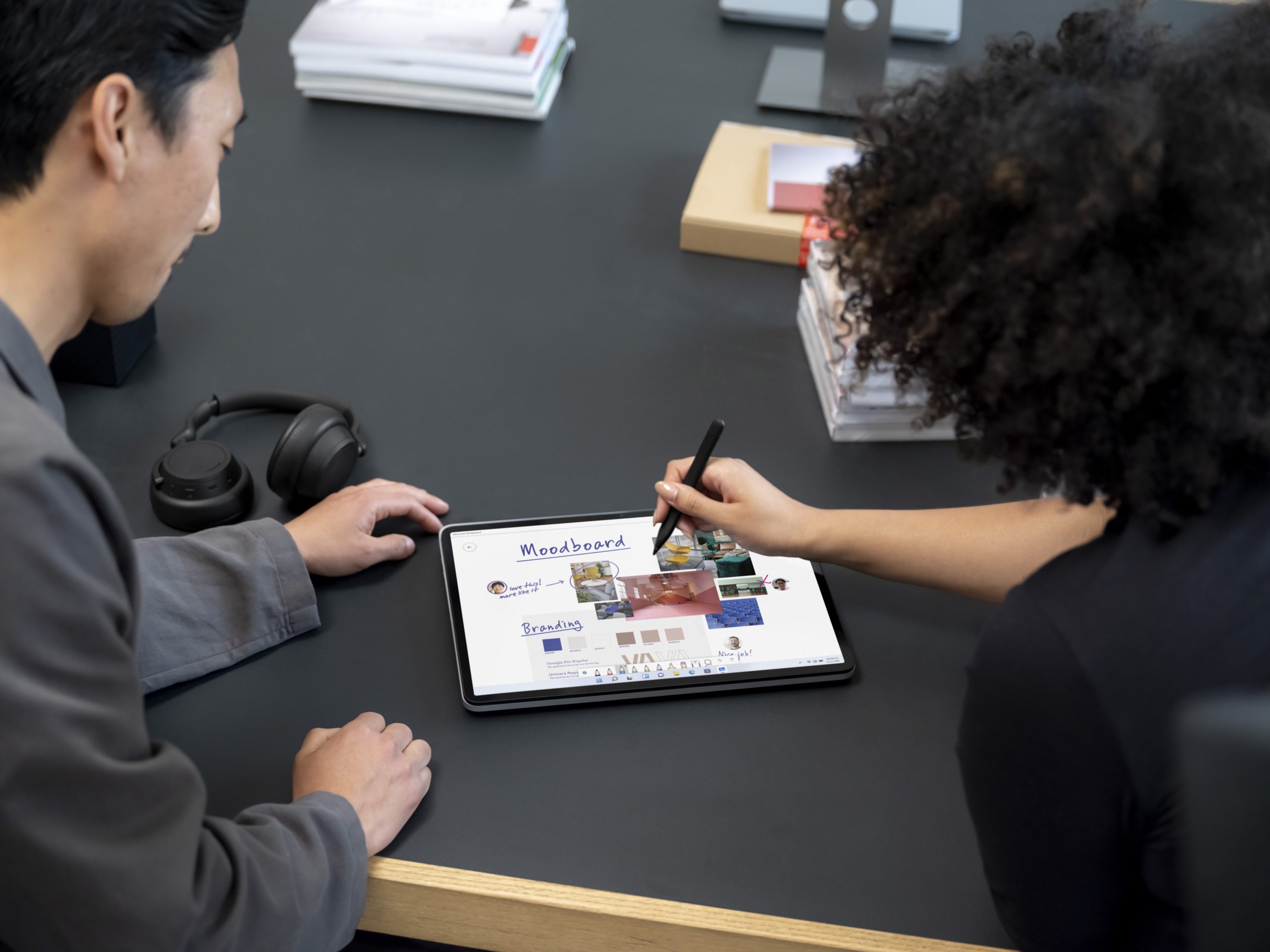Hello and welcome to series two of Microsoft Stories, a podcast about technology and the people who use it.
Over the course of this series we will speak to young people about the big issues affecting their lives and shaping their futures. We will also look at the companies and organisations playing a role in those issues, and explore how technology can be used to create innovative solutions.
In this episode we are looking at modern work. During the pandemic, most of us have had to adapt to working from home – and the good and the bad that comes with that. Not having to commute is great, but the regular interruptions and multiple people on your broadband network is not. Who has thrived over the past two years and who hasn’t? Why are young people more likely to want to work in the office? What can younger and older generations teach each other about ways of working when they finally get to sit around the same table again? We answer all these questions and more.
Click the play button and join us on our journey.
Hello and welcome to series two of Microsoft Stories, a podcast about technology and the people who use it. I’m your host Katie Gale, Philanthropies Co-ordinator at Microsoft UK. In this series I will be talking to young people and finding out about the big issues affecting their lives and shaping their futures. I also want to learn about the companies and experts who play key roles in those issues. And how does technology fit into all this and how can it be used to help tackle some of the most important challenges facing the world today?
Let’s find out!
Episode transcript:
Are you listening to this podcast at home or at work? Actually, that might be the same place these days.
For many of us, our homes have become our offices as we work through the COVID-19 pandemic. Spare rooms are now meeting rooms where we talk to colleagues via Microsoft Teams, kitchen tables have become our desks, the people we live with have become our co-workers.
In the past two years, Microsoft has seen a sixfold increase in people using communication and collaboration apps such as Teams. The PC market has seen the biggest growth in a decade. Windows now powers more than 1.4 billion monthly active devices with overall time spent on Windows up 10% over pre pandemic levels.
The pandemic has changed how, when and where we work – and these changes could be good or bad, depending on who you ask.
Companies are starting to re-open their offices, encouraging staff to take small steps back into their official workplace. It could be one day a week, or two, or more, but more of us are commuting to the office again. Microsoft’s Work Trend Index shows that work won’t return to the way it was before the pandemic. Rather, it is the start of a truly flexible way of working. Staff are expecting to split their time between their home and their office.
Here’s Nick Hedderman, Director of the Modern Work and Security Business Group at Microsoft UK.
Nick Hedderman: Employees want the best of both worlds: 73 percent of workers that Microsoft surveyed want that element of flexibility to continue, while at the same time, 67 percent are craving that in-connection and being together with their teams and with their colleagues. The data is very clear for us and, ultimately, extreme flexibility will define the post-pandemic workplace. Employees want to control where, how and when they work, and expect business leaders to provide it. The decisions business leaders make in the coming months and years ahead will really define the net decade and beyond. And enabling flexible work will ultimately help organisations to innovate, create competitive advantage and to retain and attract the very best talent.

Dive into the data on flexible working and something really interesting emerges – older staff are coping better with flexible working than younger staff. According to Microsoft’s Work Trend Index, 61 percent of leaders say they’re “thriving”, 23 percentage points higher than those not in decision-making roles, who tend to be younger. 60 percent of those aged between 18 and 25 said they are merely surviving or flat-out struggling.
This comes at a time when now, more than ever, people are expecting their employers and leaders to empathize with their situation.
Workers are facing significant challenges. Younger workers are more likely to be house sharing – imagine trying to work alongside four or five other people in your home, all trying to use the broadband, all in different rooms. There are people working in bedrooms, living rooms and kitchens, even bathrooms. And that’s happened day in and day out for two years.
Leon is a 24-year-old from London. He works as a data assistant at a college and is one of the many people we have spoken to for this podcast who is supported by charity and social business Catch22. Here’s his experience of flexible working:
Leon: I live with my brother, my sister and my mum and we’ve got four dogs, and it definitely can get loud at times when they end up barking. You don’t need that right in the middle of a meeting. It can sometimes take you away from everything, again trying to focus on work. It’s just trying to keep that focus and keep yourself disciplined to not let everything around you distract you. And it’s often just being confined to the same room at the same time. It changes how you look at that room, because it’s like, “oh, I have to go and do my work in here” and it just feels more like a slog.
Young people typically earn less and will be budgeting more than older workers, so expensive evening or weekend treats are not an option. They are also unable to create proper workplaces at home.
Microsoft’s research found that young workers are more likely to be single and more likely to feel the impact of isolation, struggle with motivation at work, find it difficult to balance work with life and feel exhausted after a typical day of work when compared with older generations.
Gen Z also reported more difficulty feeling engaged or excited about work, getting a word in during meetings, and bringing new ideas to the table when compared to other generations.
Separate research from CIPD, the professional body for HR and people development, found that young people were more likely than older workers to work in an office. In doing so, they would benefit from mentoring, learning from others and face-to-face working. There is also likely to be the appeal of dedicated working areas that contain the right digital tools at their fingertips.
Here’s Claire McCartney, senior policy adviser for resourcing and inclusion at the CIPD.
Claire McCartney: We know that older workers were working from home more than younger workers, even before the pandemic. In January of last year we surveyed employees and we found that actually it was the 18 to 24 year olds, so the youngest age group, that were least likely to say they’d like to work from home some or all of the time once the pandemic restrictions had ended.
And we know that there can be real benefits to younger workers being in an office in terms of upskilling, learning and development, access to mentoring, or shadowing other people. And I think that can be really useful at the start of their careers, so you can understand why younger people might prefer face to face working, although potentially, once they’ve had those face to face interactions, it might then be easier to work productively remotely. So I think it’s important for employers to recognize that everyone will have their own individual preferences and that organisations should offer a range of different types of flexible working, whether that’s access to remote working or other types of flexible working such as compressed hours or staggered start and finish times, to really enhance opportunities for all ages.

There is a clear generational divide in where people want to work and how they see the purpose of the office.
For young people, flexibility is key.
They want to be in the office and connect and collaborate with co-workers face to face. That helps them onboard, form working relationships, receive guidance and soak up the company culture – all issues that workers have struggled with during the pandemic, a Microsoft and YouGov study highlighted in December. The office is often the vehicle for knowledge transfer between generations.
But they also want to work from home when they need to – to look after a sick relative or wait for a repair engineer, for example. They don’t see this as a major issue, because their view isn’t based on traditional ways of working in an office every day. For them, the office space no longer stops at the office. They want to work where they want, when they want. And they want their bosses to provide the tools to help them do that.
Last year, Microsoft’s Work Trend Index found that 42 percent of employees who worked from home lacked office essentials, and one in 10 didn’t have an adequate internet connection to do their job. Despite these challenges, only 46 percent of workers said their employer helps them with remote work expenses.
While these figures relate to all age groups, younger employees are less likely to have good technology lying around the house they can use for work, and are less likely to be able to afford to buy that equipment if it’s not to hand.
Here’s Leon, from Catch22, again:
Leon: I think it’s mostly making sure that I can have the same tools that I would have at the office, at home. Post-COVID, what I’m hoping is that workplaces realize is that you need to invest a little bit more into the whole online situation, because it’s a valuable resource to have – making sure that you have resources and means to interact online, as well as being able to work in the office, in case such things happen. Remote work and Microsoft Teams has become a much more viable thing, especially for young people, at this point in time. It will open up a lot more opportunities to those that are computer literate and could do a job online.
Older workers see things differently. Yes, it’s nice to work from home but when you are in the office, you get things done. The social and cultural part of working with colleagues is secondary. Microsoft’s latest Work Trend Index, which was released in January, revealed that 70% of frontline workers said their bosses do not prioritize building a workplace culture. Company leaders are thinking: why do I need to build a culture when the purpose of the office is to work hard and hit targets?
It’s the easy option – there are rules in an office, it’s predictable, manageable. All the tools and all the people are there, and there’s no need to equip every employee with equipment tailored to their specific needs for use at home.
It’s been that way for a while. Some offices today take their influence from architect Frank Lloyd Wright. He designed the Larkin Administration Building in New York, which opened in 1906, to be like an open-plan factory, with few walls and regimented rows of desks.
Half a century later, German brothers Wolfgang and Eberhard Schnelle of the Quickborner consulting group introduced the concept of Burolandschaft, which translates as “office landscape”. This approach favoured groups of desks in an informal layout, interspersed with plants, with the aim of improving the flow of communication.
This morphed into so-called “cubicle farms” in the 1970s, but Burolandschaft has since returned and become the accepted norm for most offices.
Now flexible working brings something different – a modernisation of how we work, rather than an overhaul designed to boost productivity, which is how companies used Frank Lloyd Wright’s design.
Nick Hedderman: Microsoft research published in September – a year and a half after the pandemic hit the UK – showed that 77 percent of all employees believe their productivity hasn’t changed significantly since working in a remote environment. They still saw it as being very high, and in some cases even higher as they have been more efficient with their time. Work is still being done, targets are still being met, employees are still having a positive impact on their teams and organisations. But the key thing to remember is that everyone is different. Every individual will have their own way of working, their own way of being productive. So, the new world of flexible working will be more focused on individuals and what they need to do their very best work. NICK 2
It’s a view supported by the CIPD.
Claire McCartney: I think everyone has their own unique set of skills, experience and expertise to bring to the table … I think employers should be mindful not to stereotype any generation and recognize that everyone has something to offer. But I also think that younger workers might have less expectations when it comes to the office because they’ll have less experience of working within them, so they might be more open minded around how an office can operate, and how it can support collaboration and innovation. We know that our previous CIPD research showed that some of the benefits of fostering an age diverse workforce include knowledge sharing, greater innovation, diversity of background, by employing people from different generations, and also customer representation, which is important, so lots of benefits to come through age diverse workforces, but I think it’s really important that organisations look at how to harness those benefits through good people management practice.
There is a generational divide that has opened up around ways of working in the modern world.
But the office isn’t going away. There are significant benefits to working collaboratively alongside colleagues. But now staff have discovered that remote working is not only possible but can be preferable, and they can hold meetings and write reports without sacrificing productivity and impact. They are digital by default, but they have a purpose to get work done.
Sending everyone home to work at the start of the pandemic was a catalyst for people to re-examine their relationship with work, resulting in deep, structural changes to employee expectations. As employees learned to work differently, they started rethinking not only how, when and where they work, but why.
How do we bridge this gap? The key is communication. Leaders and employees, young and old, learning from each other about the best ways of working so everyone benefits. That includes building trust, focusing on creating a great work culture, being flexible and treating people as individuals.
Nick Hedderman: Ninety-seven percent of Microsoft employees say that their manager is supportive of their desired work style, based upon having a conversation. A conversation about how they work best. What’s more, managers who have these conversations also score higher on our annual survey when we’re looking into manager excellence. So the lesson is very clear: This is a one-on-one conversation between the manager and the employee. It helps to create trust, it helps to create a sense of shared understanding, and it ultimately empowers people to embrace their own version of what flexible work means to them.
Leaders need to actively build new habits and ensure that no matter where employees work, they feel like they belong, that they’re being included in conversations, and that management supports their diverse needs and work styles.
If you’re a manager, here’s how you can do this:
- Maintain a growth mindset through the ups and downs of the pandemic. Have a positive, forward-thinking approach that embraces every misstep as a learning opportunity, not as a failure
- Schedule regular one-to-one conversations between managers and employees. Be curious about how each employee works best, challenge assumptions and offer as much flexibility as possible
- Model, coach and care for employees, particularly young members of staff who might be still learning about their role, their team, the company and themselves
- Be clear with your team about your flexible working strategy so everyone knows what to expect. Establish meeting-free days or plan a weekly in-person team meeting
- Ensure every meeting can be attended in person and online using tools such as Microsoft Teams so everyone feels equally empowered to participate
- Don’t ignore the basics. Prioritise your people, and ensure they are prioritising their wellbeing during these turbulent times.
If you want to learn more, search online for Microsoft’s Hybrid Workplace Flexibility Guide.

Here’s Leon to explain how speaking to his manager has helped him.
Leon: I said to my boss: “Can I work at home today and do this?” He said to me that as long as you’re doing your work, you do you. Being able to have that flexibility. I hope that more workplaces realize that this flexibility is a lot healthier for some because there are some [people] that can work and [have] thrived in these two years where they’ve worked online, while others aren’t as good. Flexibility is something that needs to be treasured by employers at this point.
The pandemic has proven that organisations can trust their people to be productive wherever they are, thanks to digital tools such as Microsoft Teams and the Azure cloud. They now have an opportunity to reshape work around individual roles, preferences and even personal lives.
It’s an opportunity we must lean into to ensure we have happy and healthy staff working for managers who listen and care. And that’s good for every business.
I’m afraid that’s all the time we have for today. Thank you for listening. This is the first of two episodes focused on modern work, so make sure you look out for the next episode of Microsoft Stories soon. Bye for now!







